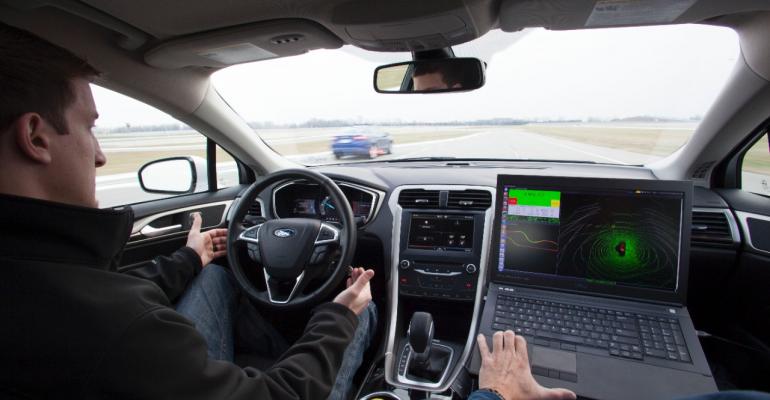PALO ALTO, CA – Ford expects to have an autonomous vehicle on the road within five years, the head of the automaker’s growing R&D effort in Silicon Valley says.
“We’re at this inflection point where we’re seeing the promise of autonomy open up new opportunities,” Kenneth Washington, vice president-research and advanced technology, says at this week’s Further With Ford trends conference.
“We are absolutely convinced this is going to be a reality within the next five years, maybe even sooner,” he says, noting automation in the industry dates back to automatic transmissions in the 1920s and has continued with innovations such as antilock braking in the 1970s.
Ford CEO Mark Fields says during a conversation with reporters at the Silicon Valley event that an autonomous vehicle or driverless car would fit within the company's century-old tradition of offering affordable transportation.
“We're going from a discovery study to an advance engineering project,” Fields says. “When we do come out with an autonomous vehicle, it’s very important that vehicle be accessible to everyone, not just to luxury customers, because that’s who we are as a company.”
Ford and other automakers have been offering driver-assistance technology such as blindspot alert since 2009. Semi-autonomous features such as collision mitigation, which apply the brakes for a driver facing a potential crash, are showing up on cars along with features such as adaptive cruise control, which can speed up and slow a car depending on traffic conditions.
“I love adaptive cruise control,” Washington says.
In addition, traffic-jam assist, which actually drives the vehicle in heavy traffic, is available on vehicles such as the Mercedes-Benz S-Class.
“The next level is fully autonomous driving,” in which the car takes over the responsibility for steering, braking and vehicle speed using an integrated onboard system that scans a 3-D map of the environment around the car, Washington says. The sensors, camera, radar, lidar software and Wi-Fi signals are integrated into one system that guides the vehicle, he says. While the technology needs to be upgraded and fine-tuned, it is available now.
The automaker recently enlisted nearby Stanford University, not far from the Ford Research and Innovation Center Palo Alto, to help accelerate development of the algorithms – the computer logic – needed to construct the system.
Ford launched the discovery study cited by Fields in 2013. The research program addresses the question of whether physics allows the possibility of a driverless vehicle. “We have answered that question, and that answer is a resounding yes,” Washington says.
“This means autonomous technology is absolutely possible. We already have sensors, cameras, software. We answered the fundamental question that it can be done.”
A more complex question involves the relationship between the vehicle and driver/passenger, Washington says: “What happens when the conversation shifts from fun to drive to fun to ride? My vehicle is my sanctuary. That’s not going to change. But we need to think beyond fun to drive.
“Drivers are really good at reading the intent of both pedestrians and other drivers,” the Ford R&D chief says. “What about when that gets handed over to an autofocus (feature in a) vehicle?
We have to rethink the user experience because this will enable us to offer the user a new class of services. This is all on top of redefining our daily commute.”
Ford is elevating the significance of its driverless-car study by turning it into an advanced-engineering project, naming a veteran engineer as head of autonomous-vehicle development. Randy Visintainer, a 29-year company veteran, will head a global team working on the advanced program.
The Ford R&D center in Silicon Valley is at the center of the team’s efforts to deliver the Ford Smart Mobility plan, which aims to take the company to the next level in connectivity, mobility, autonomous vehicles, customer experience and big data.
“During the next five years, we will move to migrate driver-assist technologies across our product lineup to help make our roads safer and continue to increase automated driving capability,” said Raj Nair, Ford group vice president-global product development.
“At the same time, we are working to make sure those features and the whole way you shop for, buy and own a Ford vehicle provides an outstanding customer experience.”
With the transition to advanced engineering, autonomous-driving technology enters the second of three phases in the process of bringing a feature to market.
As an advanced-engineering program, the Ford team is working to make the required driving and computing technology feasible for production and continuing testing and refinement of algorithms.
Ford also announces pre-collision assist with pedestrian-detection technology, already available on the Ford Mondeo in Europe, will be available in the U.S. next year on a Ford-brand vehicle. This continues the automaker’s plan to roll out the feature on most Ford products globally by 2019.
Ford says the F-150 has the most available driver-assist technology in the large light-duty pickup segment, while the Edge and Explorer lead the midsize CUV segment, Fusion tops the midsize-car segment and the Taurus leads among large cars. Each vehicle has eight available driver-assist features, according to an outside analysis.





